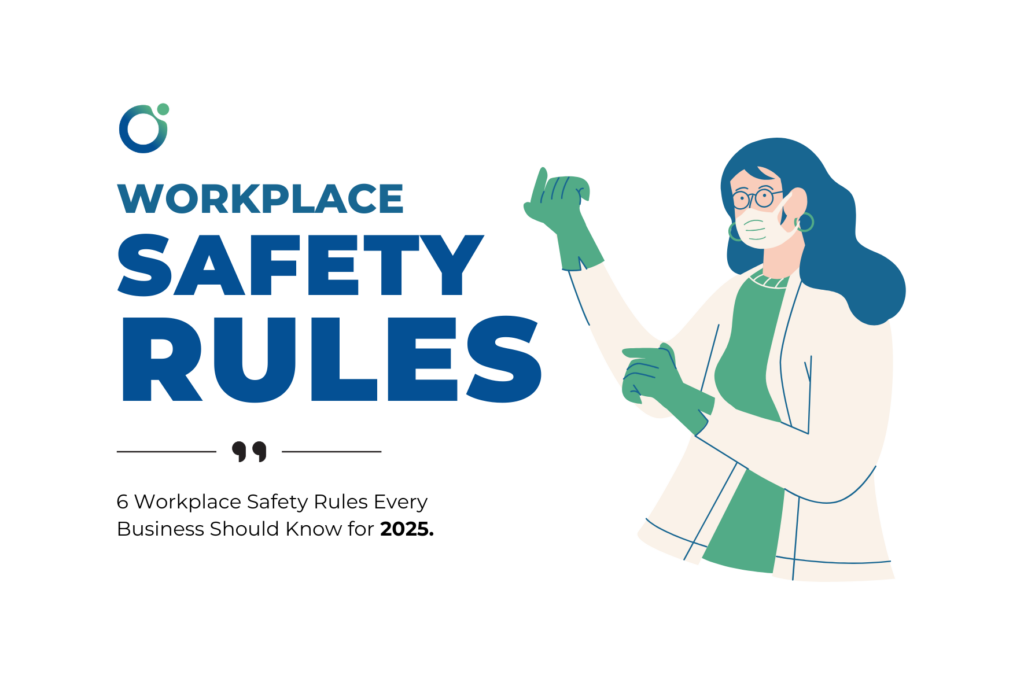By following these six safety rules, businesses can build a foundation of trust, enhance employee satisfaction, and reduce workplace injuries.

In addition to maintaining safety, businesses can maximize employee health benefits by considering Health Spending Accounts (HSAs) in Canada. Let’s dive into the most important workplace safety rules and how adopting HSA in Canada can enhance employee benefits.
1. Equip PPE per WHMIS and ISO 45001 Standards
Personal Protective Equipment (PPE) is an essential part of workplace safety, especially when dealing with hazardous materials, machinery, or high-risk environments. According to the Workplace Hazardous Materials Information System (WHMIS), employers must ensure that employees are provided with the appropriate PPE when handling hazardous substances, such as chemicals, gases, or other toxic materials. PPE is also required in specific environments where there are risks of injury, including construction sites or warehouses.

Furthermore, ISO 45001, an international standard for Occupational Health and Safety Management Systems (OHSMS), outlines the need for businesses to implement effective controls to minimize risks to employee health and safety. This includes identifying potential hazards and ensuring proper PPE is used. Implementing these safety standards will help reduce workplace accidents and protect employees.
2. Report Hazards in Compliance with OHSA and CLC
The Occupational Health and Safety Act (OHSA) in Canada requires that employers take steps to identify, assess, and control hazards in the workplace. Employees should be trained to recognize hazards and report them immediately. If employers fail to address hazards promptly, it could lead to severe accidents and injuries.
In addition, the Canada Labour Code (CLC) outlines the employer’s responsibility for the health and safety of employees, requiring them to have a formal procedure for reporting hazards. By following these regulations, businesses ensure that risks are minimized and that employees work in an environment that is safe and well-regulated.
3. Maintain Cleanliness per ISO 45001 Standards
Cleanliness and orderliness are fundamental aspects of workplace safety. Cluttered or dirty environments can lead to slips, trips, and falls, which are among the most common workplace injuries. According to ISO 45001, employers must maintain a clean and safe working environment. This includes keeping work areas free from unnecessary items, ensuring proper waste disposal, and maintaining good housekeeping practices.
By following these cleanliness standards, businesses reduce the risk of accidents and injuries while promoting a positive work environment for employees. Clean workplaces are not only safer but also boost employee morale and productivity.
4. Follow OHSA Equipment Operation Guidelines
Ensuring that machinery and equipment are used according to manufacturer instructions and safety guidelines is critical. The Occupational Health and Safety Act (OHSA) in Canada outlines the importance of ensuring that employees operate equipment only after receiving proper training. Regular maintenance and safety checks must be carried out to prevent accidents.
For small businesses with limited resources, it’s vital to implement a clear procedure for equipment usage, training, and monitoring. This way, businesses can ensure that all employees are well-equipped to use machinery safely, reducing the likelihood of injuries.
5. Implement First Aid and Emergency Protocols per CLC and ILO C155
Workplace injuries can happen despite all precautions. It’s essential to have proper first aid and emergency response protocols in place. The Canada Labour Code (CLC) requires that businesses be equipped with basic first aid supplies and that employees are trained in first aid. Moreover, the International Labour Organization (ILO) Convention C155 stresses the need for effective emergency protocols to protect employees’ health and safety.
By ensuring that your team is prepared for emergencies, you not only comply with safety regulations but also provide peace of mind to your employees, knowing that their well-being is a priority.

6. Limit Working Hours in Compliance with ILO C001
One of the simplest ways to promote workplace safety and health is by limiting working hours. Overworked employees are more likely to make mistakes and suffer from stress, fatigue, and burnout. The ILO Convention C001 outlines maximum working hours and rest periods to ensure that employees have time to recover.
In Canada, the Canada Labour Code also enforces restrictions on working hours to protect employees’ health. Employers should be mindful of the work hours of their employees to avoid health issues and maintain productivity.
Bonus: Health Spending Accounts (HSAs) in Canada
After implementing these essential safety rules, businesses in Canada can further enhance employee benefits through Health Spending Accounts (HSAs). An HSA allows employees to use pre-tax dollars for eligible medical expenses that aren’t covered by traditional health insurance, such as dental, vision, or prescription costs. This approach provides significant tax advantages for both employers and employees while maximizing health benefits.
By offering an HSA, small businesses can support their employees’ overall well-being while reducing the tax burden on the business, making it an attractive option for companies looking to provide extra value without significant extra costs.

Learn More About Wellbytes HSA
Click here to discover how Wellbytes HSA can transform your approach to employee benefits.
More about our products.
Sources:
- Government of Canada. (2015). Workplace Hazardous Materials Information System (WHMIS) 2015.
- International Organization for Standardization (ISO). (2018). ISO 45001: Occupational health and safety management systems – Requirements with guidance for use.
- Government of Ontario. (2021). Occupational Health and Safety Act (OHSA).
- Government of Canada. (2020). Canada Labour Code – Part II: Occupational health and safety.
- International Labour Organization (ILO). (1981). Occupational Safety and Health Convention (C155).
- International Labour Organization (ILO). (1919). Hours of Work (Industry) Convention (C001).
- Canada Revenue Agency. (2021). Health Spending Accounts (HSAs).
